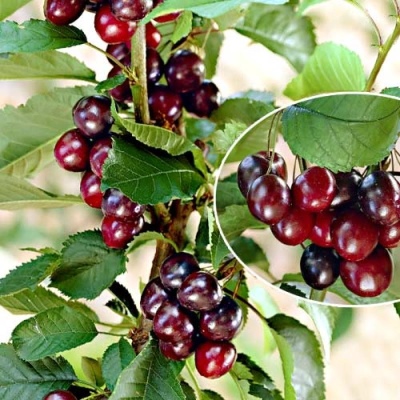
- Barrel type: wood
- Growth type: medium-sized
- Crown: narrow, cylindrical
- Leaves: light green with noticeable streaks
- Fruit size: average
- Fruit size, mm: 5
- Fruit color: red
- Fruit weight, g: 10
- Pulp (consistency): fleshy
- Taste: sweet and sour
Cherry Kudryavaya is a columnar compact variety for a small area. It can even be grown in a container.
Description of the variety
Curly Cherry is a tree of medium height, up to 2.5 meters, with a narrow elongated crown. The crown diameter does not exceed 80 cm. Growth is vertical, lateral branches grow close to the trunk. Leaves are light green, narrow. Flowers are white, large, bloom in May.
Fruit characteristics
Berries of medium size, 10-12 g each. Skin is deep red, with intense shine. The pulp is fleshy, firm and juicy.
Taste qualities
The taste is sweet and sour. The appointment is universal. This cherry is consumed fresh, independently, desserts are prepared from it, added to the first and second courses. They prepare preserves, jams, juices, jellies, wines, and liqueurs. Cherries are suitable for drying and freezing.
Ripening and fruiting
Ripening period - average, the harvest ripens by the 2nd decade of July. Early maturity - the 3rd year after planting, according to some reports, it can bear fruit for 2 years.

Yield
An average of 35 kg of berries are removed from 1 tree. This is an excellent indicator for a compact tree (on average, 15 to 40 kg are removed from cherries).
Self-fertility and the need for pollinators
The variety is partially self-fertile. For better yields, it is better to plant other varieties nearby.
Landing
They are planted either in spring, from March to May, or in autumn, from August to November. Autumn planting is preferable. The exact term depends on the region. For cherries, choose a light, sheltered from the winds. The soil is fertile, light, without moisture stagnation. Shady wetlands are unacceptable. The distance between the cherries is at least 1 meter, in rows - 1.5-2 m.The planting pit should have a depth and diameter of 70 cm.Before planting, a nutrient mixture of humus, ash and superphosphate is poured onto the bottom of the pit (1 bucket + 1 glass + 1 tbsp. L.).
Cherry is planted so that the root collar is flush with the ground, or is 2-3 cm above ground level. Gradually, with mulching and adding humus for digging, the level will be equal.


Growing and care
An annual formative and sanitary pruning will be required. In the first year, the top is cut off, the lateral branches are shortened to 10 cm so that the last bud looks out. In the 2nd year, the lateral shoots are cut to 20 cm, and the shoot replacing the tip is shortened to 30 cm. The same is true in the following years, annually increasing the length of the branches left.When the tree reaches the desired height, the replacement shoot is pinched so that it no longer grows. In the following years, the side branches are cut once every 3 years. Plants in the container are pruned more intensively. In the first 2 years, the first buds may appear, they are pinched off to form a strong tree.
The tree has a relatively high winter hardiness. In warm regions of the Russian Federation, she does not need shelter for the winter. However, in the early years it is better to play it safe. A young tree is mulched or hidden under a frame. In the middle lane, shelter is required.
Watering 2-3 times a week with moisture penetration into the soil by 30-40 cm. In hot weather, watering is increased up to 1 time per week. Be sure to make sure that moisture does not stagnate. The soil should dry out between waterings. Smooth, verified watering affects the quality of berries, avoids cracking, and improves taste. If it is not possible to flexibly regulate watering according to the weather, the soil is mulched - this evens out the sensations of the tree. In dry autumn, before sending for wintering, water-charging irrigation is required.
Top dressing is combined with watering. They are fed once every 2 months. In early spring, they are fed with urea. During the growing season, 1-2 additional fertilizing with complex mineral fertilizer for fruit crops will be required. Ash solution can be used instead of industrial fertilizers. In autumn, phosphorus and potash fertilizers are applied (100 g and 50 g per tree). Mature plants can be fed less often, but in the fall, the site is dug up on a half-bay of a shovel with fresh compost. If the site is rich in soil, minerals should be fed no more than 1 time per year.
The variety has an average resistance to diseases, therefore, certain care measures are needed.
Autumn whitewashing of the trunk.
In early spring, before the buds dissolve, the branches are sprayed with Bordeaux liquid.
During the year, several times are treated with "Fitosporin". This is a biological product, it is safe for the crop.
When signs of the most common disease of stone fruit moniliosis appear, the tree is sprayed with fungicides. Preventive autumn care is mandatory: thorough cleaning of the site, only fresh mulch, all damaged branches and leaves are removed and burned.



Review overview
There are no reviews of the variety. Column-shaped cherries make buyers wary. The natural features of cherry growth, indeed, do not imply the formation of a true column, as in apple trees, but compact, convenient forms for a small garden have been bred for a long time. Cherry Curly has the necessary potential to form a neat tree. Columnar cherries are susceptible to frost, and berries do not tend to be stored for long. Taking into account these features, Curly cherry will delight with the harvest and will be an excellent choice for owners of small gardens.































































